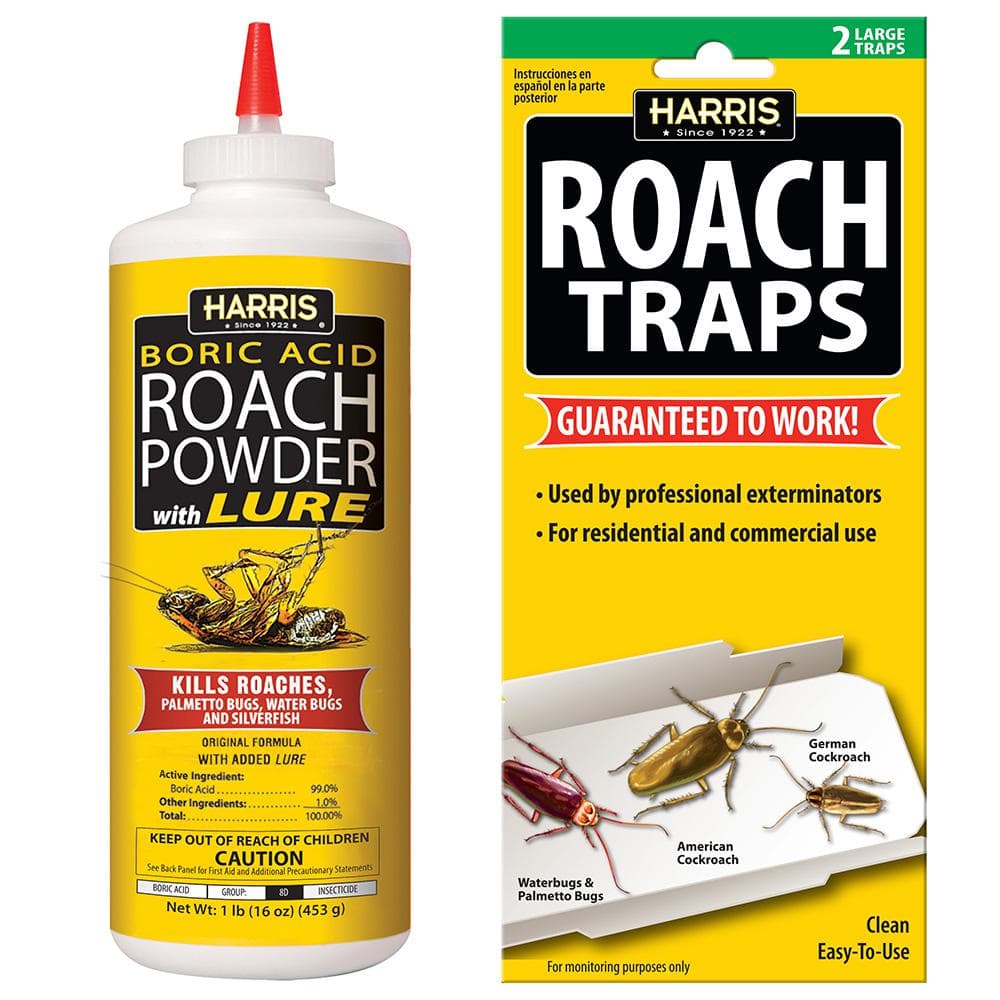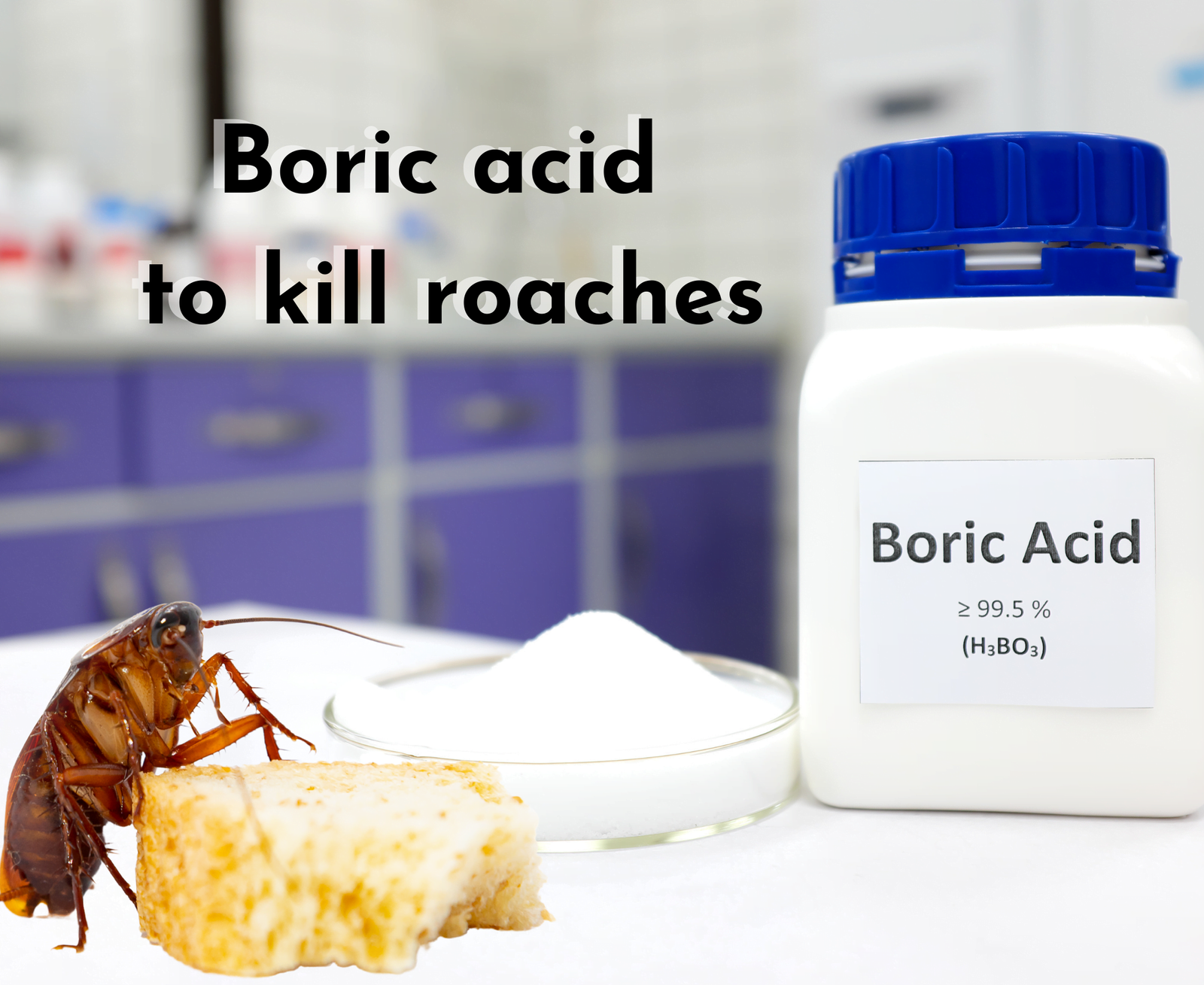When cockroaches ingest boric acid, it disrupts their digestive systems and their exoskeletons. The powder is lethal as it acts as a poison to these pests.
Boric acid, often found in powdered form, is a well-known insecticide used to control cockroach infestations effectively. It targets cockroaches by damaging their stomach lining and nervous system upon ingestion, leading to their death. This substance sticks to the roach’s body as they crawl over it.
As roaches clean themselves, they ingest the boric acid, which proves fatal. Not only is boric acid efficient in killing individual cockroaches, but it can also eliminate entire colonies since affected roaches often return to their nesting area, spreading the poison to others. Safe for use in homes when applied correctly, it remains one of the go-to remedies for those seeking to rid their spaces of these resilient pests. Its popularity is due in part to its effectiveness, low cost, and ease of use, making it a staple in the pest control arsenal.

Credit: entomologytoday.org
The Cockroach: A Survivor’s Profile
Imagine a creature so tough, it can outlive dinosaurs. Enter the cockroach, a resilient insect capable of thriving where others can’t. Despite their reputation, cockroaches’ survival skills spark both awe and curiosity. Let’s delve into the secrets of their resilience. Understanding these survivors is crucial, especially when discussing what happens when they encounter boric acid, a common pesticide.
Resilience And Adaptability
Cockroaches are legendary for their survival skills. They adapt to almost any environment.
- Hardy exoskeletons protect them from physical harm.
- They can live without food for a month.
- They can scavenge on diverse nutrients, even glue from postage stamps.
This adaptability poses a challenge to eradicating them, especially in the home.
Common Habitats And Diet
Cockroaches are not picky about where they live or what they eat.
| Habitats | Diet |
|---|---|
| Kitchens | Crumb scraps |
| Bathrooms | Soap residue |
| Basements | Cardboard |
This ability to adapt is what makes them fascinating yet tricky pests to control. Introducing boric acid changes the game for these otherwise tough insects.

Credit: www.homedepot.com
Boric Acid: The Insect Antagonist
Boric acid, a household name in pest control, acts like a silent ninja against the resilient cockroach. It hides in plain sight in many common products. This seemingly simple substance packs a punch against pests. Let’s dive into what happens when cockroaches encounter this foe.
Chemical Properties And Usage
Boric acid is a white powder derived from boron and water. Its uses range widely.
- Antiseptic for minor cuts
- Preservative in many products
- Cockroach and ant killer, hidden in baits
It holds a low toxicity level to humans and pets when used properly. This makes it a popular choice for in-home pest control.
Mechanism Of Action Against Pests
Boric acid acts as a stomach poison for cockroaches. The process is quite fascinating.
- Cockroaches ingest boric acid from treated surfaces or baits.
- Once inside, it disrupts their digestive system.
- Affects the pest’s metabolism, leading to death.
This method does not repel cockroaches. It kills them effectively after ingestion.
Encounter With The Poison
Cockroaches are survivors, but boric acid is their weakness. When these pests encounter this substance, a deadly series of events unfolds, sealing their fate. Understanding how they ingest boric acid and the effectiveness of baits and traps can help in controlling their populations.
How Cockroaches Ingest Boric Acid
Roaches are nocturnal, foraging for food at night. They crawl over boric acid powder, unknowingly getting it on their legs and bodies. Grooming themselves, they ingest the powder, which acts as a stomach poison.
- Cleaning habits cause ingestion
- Boric acid disrupts their digestive systems
- Death follows within 72 hours
Boric Acid Baits And Traps
Baits contain a lure that attracts roaches. Combined with boric acid, these baits lead to effective pest control. Traps work similarly, enticing roaches with bait before trapping them. The boric acid inside ensures they won’t escape.
| Bait/Trap Type | Attraction Method | Containment |
|---|---|---|
| Gel Baits | Food-Based Lure | Poison Ingestion |
| Sticky Traps | Baited Scent | Physical Containment |
Internal Corruption: Boric Acid At Work
Imagine a tiny intruder sneaking into a cockroach’s body, wreaking havoc from the inside. That’s what boric acid does. It’s a common, low-toxic method to control pesky roaches. This white, powdery substance is a roach nightmare. Once ingested, it starts a lethal journey through their system. Let’s explore exactly how boric acid spells doom for these unwelcome guests.
Disrupting The Cockroach’s Digestive System
When roaches crawl over boric acid, they often clean themselves and swallow it. Inside, boric acid disrupts their digestion.
- Damages the stomach lining, causing malnutrition.
- Interferes with their metabolism, exhausting them quickly.
- Leads to dehydration and eventual death.
Neurological Effects On Pests
Boric acid doesn’t stop at the gut. It also affects the roach’s nervous system.
- It weakens neural responses, leading to lack of coordination.
- Toxic effects occur, crippling neural pathways.
- The roach loses muscular control and cannot function.
The Endgame Effect
Boric acid is a common ingredient in pest control. When cockroaches ingest it, a deadly aftermath unfolds, called the Endgame Effect. Let’s unveil what this entails for these pesky critters.
Physical Symptoms Of Poisoning In Cockroaches
Cockroaches show distinct signs when poisoned by boric acid. Their bodies can’t handle this substance. Here are the symptoms:
- Dehydration – Boric acid dries them out from the inside.
- Disrupted digestion – It damages their stomachs, stopping normal food processing.
- Muscle convulsions – Toxicity leads to uncontrolled twitching and shaking.
- Energy loss – They become lethargic, moving less and less.
Timeline To Mortality
Cockroaches don’t die immediately. The timeline from ingestion to death differs based on several factors:
| Amount Ingested | Approximate Time to Death |
|---|---|
| Small dose | 72 hours |
| Large dose | 24 hours |
A tiny amount may take up to three days to kill a cockroach. A larger dose can work within one day. Factors like size and health of the cockroach also play roles.
Collateral Damage: Impact On The Colony
When dealing with a cockroach infestation, boric acid plays a pivotal role. Sure, individual roaches may ingest it, but the true power unfolds when you consider the colony-wide implications. As roaches are social creatures, their habits could spread the boric acid throughout the colony, leading to unexpected “collateral damage”. Let’s delve into how boric acid affects not just one roach, but has the potential to impact an entire cockroach population.
Secondary Poisoning In Cockroach Populations
Secondary poisoning, a key aspect in pest control, occurs when toxins transfer from one infected individual to others. With cockroaches, this happens in a couple of ways:
- Cannibalism: Cockroaches may eat their deceased compatriots, ingesting the boric acid.
- Fecal Matter: Healthy roaches come into contact with contaminated droppings.
This chain reaction can cause a significant decline in their numbers, even wiping out entire colonies.
Behavioral Changes In Affected Cockroaches
Roaches exposed to boric acid manifest several behavioral changes:
- Feeding habits change, leading to more ingestion of poisoned bait.
- Some may isolate themselves, limiting to their hiding spots.
- Affected roaches are less cautious, making them more prone to traps.
These changes can hasten the spread of boric acid within the cockroach community, bringing about a faster collapse of the population.
Efficacy And Limitations Of Boric Acid
When it comes to dealing with cockroach infestations, one popular weapon of choice among homeowners is boric acid. This substance, which appears as a white powder, holds a reputation for being an effective roach killer. However, like all treatments, it has its strengths and its own set of limitations.
Boric acid works by affecting a cockroach’s digestive system and exoskeleton. When ingested or coming into contact with their bodies, it leads to dehydration and death. Despite its compelling properties, its efficacy can be influenced by factors like application method and cockroach behavior. Let’s delve deeper into how boric acid compares with other insecticides and the challenges it faces, such as resistance and avoidance.
Comparing Boric Acid With Other Insecticides
Boric acid stands out for its affordability and low toxicity to pets and humans, compared to other insecticides. Here’s a quick glance at how boric acid fares against its competitors:
- Long-lasting: It remains potent as long as it’s kept dry.
- Safety: Less toxic for household use.
- Cost-effective: More affordable than many professional treatments.
But, not all insecticides are created equal. Chemical alternatives often promise quicker results but come with a higher risk factor.
Challenges Of Resistance And Avoidance
The combat with cockroaches does not end with the choice of weapon; the adversaries are crafty. Over time, roaches can develop resistance to boric acid, just as they can to other insecticides. They may even learn to avoid treated areas, rendering the poison less effective.
To overcome these hurdles, it’s essential to implement a diverse pest control strategy. Combining boric acid with other methods, such as sanitation and exclusion tactics, can help ensure victory over these persistent pests.
Safe And Strategic Use Of Boric Acid
Boric acid, a common ingredient in many pest control solutions, targets unwanted house guests like cockroaches. When used correctly, it can be an effective means to rid your home of these persistent pests. Proper application not only ensures the elimination of cockroaches, but also minimizes risk to humans and pets. Let’s explore how to use boric acid safely and strategically.
Precautions And Best Practice Guidelines
To achieve the best results with boric acid, follow these guidelines:
- Wear gloves when handling boric acid.
- Apply boric acid in fine layers, as roaches avoid piles.
- Focus on areas where roaches are likely to travel.
- Keep boric acid away from food surfaces and utensils.
- Store boric acid out of reach of children and pets.
Remember, boric acid is only effective when roaches walk through it. It must stick to their bodies for ingestion to occur.
Environmental Considerations
Environmental safety is key when using pesticides like boric acid. Consider the following:
- Avoid placing boric acid near air vents to prevent dispersion.
- Use just enough to cover target areas and reduce waste.
- Do not apply outdoors, as it can affect local wildlife.
Boric acid is a low-toxicity option for roach control, but it must still be treated with respect for our environment.

Credit: www.amazon.com
Frequently Asked Questions
How Do Roaches Act After Eating Boric Acid?
After ingesting boric acid, roaches become dehydrated and their nervous systems malfunction. This leads to decreased mobility, feeding, and eventual death.
How Long Does It Take Boric Acid Tablets To Kill Roaches?
Boric acid tablets typically kill roaches within 1 to 3 days after ingestion by the insect. The speed of effectiveness can vary based on the size of the roach and the level of infestation.
How Long Does It Take For Borax To Kill Roaches?
Borax can kill roaches within 72 hours after ingestion, depending on the dosage and the roaches’ size.
Is Boric Acid Poison For Cockroaches?
Yes, boric acid is a poison that effectively kills cockroaches by affecting their digestive and nervous systems.
Conclusion
Wrapping up, boric acid proves to be a formidable foe against cockroach invasions. It targets their digestive systems and metabolism, leading to effective pest control. Remember, accurate application is key to safety and success. Adopting this method can ensure a roach-free environment, making it a reliable ally in your home’s defense strategy.
Related posts:

I’m MD Tanvir, and I bring years of expertise gained from working closely with pest control companies to the forefront. My journey in the industry has inspired me to launch Bug Battler, a platform aimed at equipping people with the know-how to combat pests autonomously. Through Bug Battler, I aim to empower individuals with practical insights to tackle pest infestations effectively.

